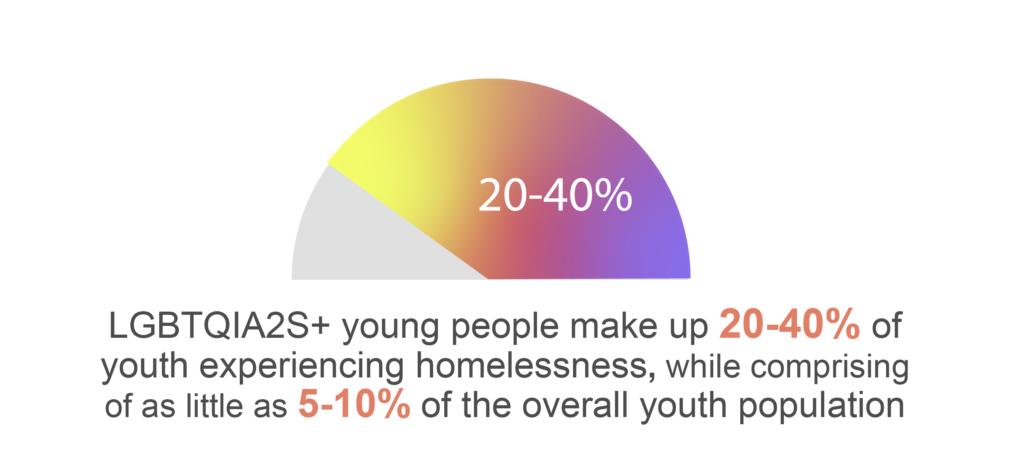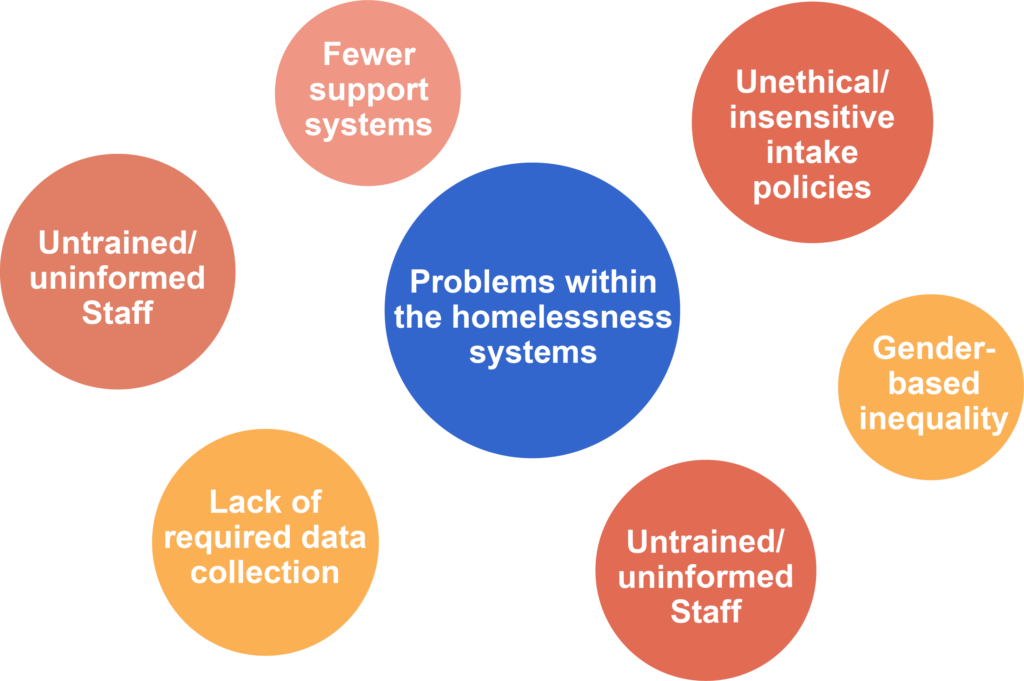Transgender and gender non-conforming youth face a disproportionately high risk of homelessness, with studies showing they are 120% more likely to experience homelessness compared to cisgender and heterosexual youth. Once homeless, these youth encounter unique challenges and barriers to accessing safe housing, supportive services, and pathways to housing.

Transgender and Gender Non-Conforming (TGNC) Youth Homelessness
TGNC youth are significantly overrepresented in the homeless population. A population-based survey in Minnesota found that 2.7% of adolescents identified as TGNC, but 6.7% of these youth reported experiencing homelessness with their families, and 3.6% reported being homeless unaccompanied, compared to just 3.5% and 1.1%, respectively, for cisgender youth. Studies in 2012 also estimated that LGBTQ youth make up 7-39% of the homeless youth population, despite comprising only 5-7% of the overall youth population—transgender youth, in particular, face unique risks and trajectories into homelessness. Many are forced to leave home due to a lack of acceptance and support from their families surrounding their gender identity. Once homeless, 85% of transgender youth report avoiding shelters altogether for fear of mistreatment and harassment by staff and other residents. Of those who do seek shelter, 41% are denied access, often explicitly due to their gender identity. These factors lead to transgender youth being heavily overrepresented among the unsheltered homeless population – 63% of transgender individuals and 80% of non-binary individuals experiencing homelessness were unsheltered in 2019. Addressing the crisis of transgender youth homelessness requires ensuring welcoming, gender-affirming shelter options and focusing on family acceptance to prevent youth from becoming homeless due to rejection.


Unique Problems TGNC Youth Experience in the Homelessness Services
TGNC youth face numerous unique challenges and barriers when experiencing homelessness:

Discrimination and Mistreatment in Shelters
Many homeless shelters segregate housing by sex assigned at birth rather than gender identity, forcing trans youth into facilities inconsistent with their gzender. This exposes them to harassment, abuse, and lack of privacy from other residents.
Even in shelters that house clients according to gender idenity, lack of staff training and supervision can enable the victimization of trans youth by other residents
Studies show a staggering 41% of transgender individuals report being denied access to shelters explicitly due to their gender identity.
55% of transgender individuals were harassed by shelter staff or residents when trying to access a homeless shelter, and 22% were sexually assaulted.
Rejection from Family and Support Systems
A significant driver of homelessness for trans youth is rejection and lack of acceptance from families due to their gender identity. Up to 26% report being forced out solely because they are transgender.
With fewer support systems, trans youth have limited options when facing a crisis that leads to homelessness.
Unsafe Survival Behaviors
Lacking services, some trans youth experiencing homelessness resort to survival sex work and other risky behaviors for basic needs like food and shelter, increasing HIV/STD risks.
Lack of Appropriate Services
Homeless services often lack cultural competency training to properly support and house transgender clients according to their gender identity.
Gender non-conforming youth face additional barriers, with few shelters offering gender-neutral housing facilities.
It is also worth noting that there is limited information on gender non-conforming homelessness, including youth, due to a lack of data collection and services available to this specific youth population.
Health and Safety Risks
Unmonitored use of street hormones and unsafe injection of silicone/oils for feminization can lead to serious medical issues like blood clots and pulmonary problems.
Transgender youth experiencing homelessness face higher rates of mental health issues, substance abuse, victimization, and suicide attempts compared to cisgender homeless youth.

How to Improve Systems to be Justice-Focused, Equitable, and Inclusive for TGNC Youth Experiencing Homelessness
Youth homelessness systems can take several steps to become more just, equitable, and inclusive for TGNC youth:
Implement Robust Non-Discrimination Policies
Enact and enforce clear policies prohibiting discrimination based on gender identity/expression in all housing and service programs.
Ensure staff are appropriately trained on the policies and understand their role in creating an affirming environment.
Provide Gender-Affirming Housing Options
Allow TGNC youth to access housing consistent with their gender identity, not the sex assigned at birth.
Offer gender-neutral housing and bathroom facilities for non-binary youth.
Do not isolate or segregate TGNC youth from their peers as a safety measure.
Increase Cultural Competency
Comprehensive cultural competency training is required for all staff on TGNC identities, experiences, and needs.
Hire staff from the TGNC community to provide peer support and mentorship.
Use proper names/pronouns and avoid invasive questions about gender identity/transition.
Strengthen Family Support Services
Provide family counseling to increase acceptance of a youth’s gender identity and reduce rejection, a significant driver of TGNC homelessness.
Connect families to TGNC community resources and support groups.
Improve Data Collection
Accurately capture gender identity data during intake to better understand and serve the TGNC population.
Involve TGNC youth in data governance to ensure ethical and empowering data practices.
Partner with TGNC Organizations
Collaborate with TGNC-led organizations to inform policies, train staff, and provide tailored services.
Support leadership opportunities for TGNC youth within the system.
Addressing discrimination, ensuring safe and affirming housing, building competency, strengthening family support, ethical data practices, and elevating TGNC voices are vital to making homelessness systems more just and inclusive for this vulnerable population.
What System Change Partners Can Provide and Recommends
System Change Partners can play a crucial role in driving systems-level changes to make youth homelessness responses more inclusive, equitable, and justice-focused for transgender and gender non-conforming (TGNC) individuals. Here are some key ways we can contribute:
Facilitate Community Partnerships
System Change Partners can facilitate partnerships between youth homelessness systems and TGNC-led organizations and provide best practices to work with TGNC with lived experience to co-create more inclusive policies, practices, and services. By bringing these partners together, we can ensure TGNC voices and lived expertise are centered in decision-making processes.
Revise Coordinated Entry Processes
We can guide revising coordinated entry systems to be more affirming and accessible for TGNC youth. This includes implementing gender-inclusive intake forms, ensuring safe and appropriate emergency shelter placements based on gender identity, and training staff on cultural competency.
Strengthen Family Acceptance Services
We can support efforts to strengthen family counseling and support services aimed at increasing acceptance of a young person’s gender identity. Reducing family rejection, a significant driver of TGNC youth homelessness is crucial for prevention.
– Isaac Sanders